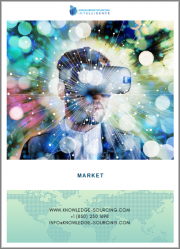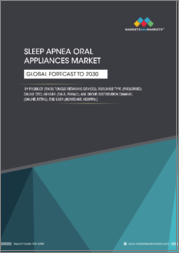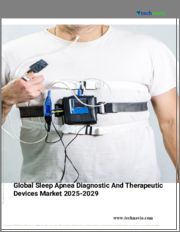
|
시장보고서
상품코드
1410139
세계 가정용 수면 무호흡 증후군 장치 시장 예측(2023-2028년)Home-Based Sleep Apnea Devices Market - Forecasts from 2023 to 2028 |
||||||
가정용 수면 무호흡 증후군 장치 시장은 2021년 15억 5,600만 달러에서 2028년에는 45억 2,300만 달러에 달하고, CAGR 16.47%로 성장할 것으로 예측됩니다.
가정용 수면 무호흡 증후군 장치 시장은 수면 무호흡 증후군의 유병률 증가와 잠재적인 건강 피해에 대한 의식이 증가함에 따라 최근에 크게 성장하고 있습니다. 이러한 최첨단 기술은 집에 있는 동안 수면 무호흡 증후군을 모니터링하고 진단하는 간단하고 비침입적인 방법을 제공합니다. 이러한 가정용 시스템은 기류 센서, 펄스 옥시메트리, 웨어러블 가젯과 같은 혁신적인 기술을 활용하여 수면장애를 정확하게 감지하고 의료 전문가에게 중요한 데이터를 제공할 수 있습니다. 환자의 원격 모니터링과 원격 의료가 중시되고 수면 무호흡 증후군 관리에 비용 효율적이고 사용하기 쉬운 옵션을 제공하는 이러한 장치 수요에 박차가 걸리고 있습니다. 세계 인구가 더 나은 수면을 추구함에 따라 가정용 수면 무호흡 증후군 장치 시장은 향후 수년간 꾸준히 확대될 것으로 예상됩니다.
수면 무호흡 증후군의 유병률 상승이 가정용 수면 무호흡 증후군 장치 시장의 성장을 가속.
수면 무호흡 증후군의 유병률 증가는 가정용 수면 무호흡 증후군 장치 시장의 주요 성장 요인입니다. 세계 인구의 상당한 비율이 수면 무호흡 증후군을 앓고 있으며 수면 중 호흡 장애를 특징으로하는 수면 질환입니다. 라이프 스타일의 변화, 비만, 노화, 수면 문제에 대한 의식 증가 등이이 질병의 이환율 상승에 기여하고 있습니다. 그 결과, 수면 무호흡 증후군을 모니터하고 진단할 수 있는 효과적이고 편리한 가정용 장치에 대한 요망이 높아지고 있어, 사람들은 집에 있으면서 질병을 관리할 수 있게 되었습니다. 시장 개척과 건강 관리 제공업체는 환자의 확대 요구에 부응하고 수면 무호흡 증후군이 공중 보건 시스템에 미치는 영향의 확대를 완화하기 위해 이러한 장비 개발 및 판매에 적극적으로 투자합니다.
가정용 수면 무호흡 증후군 장치 시장에서의 가정용 장치의 기술적 진보.
가정용 수면 무호흡 증후군 장치의 기술 개척은 시장 확대의 주요 원인입니다. 이러한 발전으로 보다 복잡하고 사용하기 쉬운 장치가 개발되어 개인의 수면 무호흡 증후군의 제어가 용이해졌습니다. 고급 센서와 알고리즘을 통해 수면 패턴, 호흡 이벤트 및 산소 수준을 모두 정확하고 실시간으로 모니터링할 수 있습니다. 또한 소형화와 웨어러블 기술은 이러한 가젯의 편안함과 휴대성을 향상시켜 사용자가 안심하고 수면을 취할 수 있게 되었습니다. 스마트폰 및 기타 스마트 장치와의 통합은 부드러운 데이터 전송 및 분석을 가능하게 하고, 환자 및 의료 전문가에게 개인화된 치료 프로그램에 대한 유익한 통찰력을 제공합니다. 기술이 발전함에 따라 가정용 수면 무호흡 증후군 장치 시장은 더욱 개척이 진행되어 환자의 예후를 개선하고 수면의 건강 증진을 촉진할 것으로 예측됩니다.
편의성과 비침입형 모니터링이 가정용 수면 무호흡 증후군 장치 시장 규모를 밀어 올립니다.
가정용 수면 무호흡 증후군 장치가 제공하는 사용 편의성과 비침입형 모니터링은 수용과 시장 확대에 중요한 역할을 합니다. 이러한 가젯은 기존 실험실 내 수면 연구와 달리 개인의 개인 정보를 보호하면서 수면 패턴과 호흡 에피소드를 추적할 수 있습니다. 이 비침입적인 방법은 수면 센터에서의 숙박의 필요성을 없애고, 고통을 줄이고, 수면의 질 향상을 촉진합니다. 사용자는 웨어러블 장치를 착용하거나 비침습적인 센서를 장착함으로써 표준 수면 모니터링 장치의 번거로운 설정이 필요하지 않습니다. 이러한 장치를 일상생활에 도입함으로써 지속적이고 방해받지 않는 데이터 수집이 가능해져 환자와 헬스케어 제공업체 모두에게 수면의 질 평가, 수면장애의 검출, 개인에 맞춘 치료 계획의 입안과 같은 귀중한 통찰력을 제공하고 결국 환자의 컴플라이언스와 수면 전체의 건강을 개선합니다.
북미가 가정용 수면 무호흡 증후군 장치 시장 시장 리더입니다.
북미는 가정용 수면 무호흡 증후군 장치 시장 시장 리더입니다. 이는 이 지역의 수면 무호흡 증후군의 유병률 증가, 확립된 건강 관리 인프라, 수면장애에 대한 일반 시민의 의식 증가 등 많은 변수에 기인합니다. 또한, 북미에서는 기술의 대폭적인 향상과 바람직한 규제 환경이 가정용 수면 무호흡 증후군 장치의 도입을 뒷받침하고 있습니다. 중요한 시장 기업의 존재, 연구 개발에 대한 노력, 고급 웨어러블 기술의 가용성으로 이 지역은 가정용 수면 무호흡 증후군 장치 시장의 혁신과 성장을 추진하는 선구자로서의 지위가 강화되었습니다. 했습니다.
가정용 수면 무호흡 증후군 장치 시장에서 지속적인 수면 건강 모니터링에 대한 수요.
전반적인 건강 상태에서 수면의 중요성이 인식되고 있기 때문에 지속적인 수면 건강 모니터링의 요구가 커지고 있습니다. 수면이 신체적, 정신적 건강에 미치는 영향에 대한 인식이 높아짐에 따라, 개인은 수면 습관을 모니터링하고 잠재적인 수면 문제를 확인하는 기술을 요구하고 있습니다. 지속적인 수면 건강 모니터링을 통해 수면의 질, 호흡 사건 및 수면 관련 지표를 지속적으로 평가할 수 있으며, 개인의 수면 건강의 전체 이미지를 시간에 걸쳐 파악할 수 있습니다. 지속적인 모니터링은 가정용 수면 무호흡 증후군 장치 및 웨어러블 기술에 의해 제공되며, 사용자는 자신의 수면 패턴을 분석하고, 수면 중단을 확인하고, 수면 습관을 개선하기 위한 현명한 결정을 내릴 수 있습니다. 수 있습니다. 또한 건강 관리 제공업체는 종단 데이터에 액세스할 수 있어 보다 정확한 진단, 개인화된 치료, 수면 관련 질환의 적극적인 관리가 가능해져 환자의 결과가 개선됩니다.
주요 발전:
2023년 6월 의료기술의 세계 선구자인 Royal Philips와 세계 의료기술사인 Masimo는 Philips의 환자용 모니터인 인텔리뷰 MX750과 MX850의 세드라인 뇌기능 모니터링, 국소 옥시메트리, CO2 측정 값이 FDA 허가를 받았다고 발표했습니다. Masimo와 Philips의 지속적인 파트너십에서의 최신 발전은 추가 모니터링 장치를 필요로 하지 않고 의사가 신속하고 충분한 정보를 바탕으로 판단을 내릴 수 있도록 지원합니다. 2022년 7월, 뇌, 신경경로, 8가지 감각신경계에 영향을 미치는 장애를 선별, 진단, 치료하는 의료기기 솔루션의 선두 업체인 Natus Medical Incorporated는 의료 산업에만 특화된 주요 투자 회사인 ArchiMed의 MED Platform II 펀드에 인수됨을 발표했습니다. 공식 합병 계약에 따르면 Natus의 주주는 Natus의 보통주 1주당 현금 33.50달러를 받았습니다.
기업 제품
- CPAP 기계: ResMed는 폐색성 수면 무호흡 증후군(OSA)의 치료에 일반적으로 사용되는 지속적인 양압 호흡기(CPAP) 장치로 잘 알려져 있습니다. 이 장치는 마스크를 통해 일정한 공기 흐름을 제공하고 수면 중에기도를 열린 상태로 유지하며 호흡의 휴지를 방지합니다.
- 자동 CPAP(APAP) 장치: Philips Respironics에서 제공하는 자동 조절 CPAP 장치는 야간 환자의 호흡 패턴에 따라 기압 수준을 자동으로 변경하여 최적의 치료와 편안함을 보장합니다.
- 바이레벨기도양압(BiPAP)장치: Drive DeVilbiss Healthcare는 흡기시와 호기시 두 개의 별도 기압수준을 제공하는 BiPAP장치를 발표했습니다. 이 장치는 더 복잡한 수면 무호흡 증후군을 가진 사람과 더 높은 압력의 도움이 필요한 사람들에게 적합합니다.
- CPAP 마스크 및 액세서리 BMC Medical Co., Ltd.는 코 마스크, 코 베개, 풀 페이스 마스크와 같은 다양한 CPAP 마스크와 치료 중 편안함과 컴플라이언스를 향상시키기위한 튜브, 필터 및 가습기와 같은 액세서리 를 제공합니다.
목차
제1장 서론
- 시장 개요
- 시장의 정의
- 조사 범위
- 시장 세분화
- 통화
- 전제조건
- 기준년과 예측년의 타임라인
제2장 조사 방법
- 조사 데이터
- 정보원
- 조사 디자인
제3장 주요 요약
- 조사 하이라이트
제4장 시장 역학
- 시장 성장 촉진요인
- 시장 성장 억제요인
- Porter's Five Forces 분석
- 공급기업의 협상력
- 구매자의 협상력
- 신규 참가업체의 위협
- 대체품의 위협
- 업계 내 경쟁 기업간 경쟁 관계
- 업계 밸류체인 분석
제5장 가정용 수면시 무호흡 증후군 장치 시장 : 장치유형별
- 소개
- 기도 양압(PAP) 장치
- 지속기도양압(CPAP)장치
- 바이레벨기도양압(BIPAP)장치
- 구강기구
- 어댑티브 서보 환기(ASV) 장치
- 산소 장치
- 기타
제6장 가정용 수면시 무호흡 증후군 장치 시장 : 용도별
- 소개
- 매뉴얼
- 자동
제7장 가정용 수면시 무호흡 증후군 장치 시장 : 최종 사용자별
- 소개
- 병원 및 수면 클리닉
- 가정치료 환경
- 수면 센터
- 기타
- 가정용 수면시 무호흡 증후군 장치 시장 : 지역별
- 소개
- 북미
- 미국
- 캐나다
- 멕시코
- 남미
- 브라질
- 아르헨티나
- 기타
- 유럽
- 영국
- 독일
- 프랑스
- 이탈리아
- 스페인
- 기타
- 중동 및 아프리카
- 사우디아라비아
- 아랍에미리트(UAE)
- 기타
- 아시아태평양
- 일본
- 중국
- 인도
- 한국
- 인도네시아
- 대만
- 기타
제8장 경쟁 환경과 분석
- 주요 기업과 전략 분석
- 신흥기업과 시장수익성
- 합병, 인수, 합의 및 협업
- 벤더 경쟁력 매트릭스
제9장 기업 프로파일
- RESMED INC.
- KONINKLIJKE PHILIPS NV
- FISHER & PAYKEL HEALTHCARE LIMITED
- INVACARE CORPORATION
- DRIVE DEVILBISS HEALTHCARE
- BMC MEDICAL CO., LTD.
- COMPUMEDICS LIMITED
- NATUS MEDICAL INCORPORATED
- NIHON KOHDEN CORPORATION
- APEX MEDICAL CORP.
The home-based sleep apnea devices market is expected to grow at a CAGR of 16.47% from US$1.556 billion in 2021 to US$4.523 billion in 2028.
The home-based sleep apnea devices market has grown significantly in recent years, owing to the increasing prevalence of sleep apnea and greater awareness of its potential health hazards. These cutting-edge technologies provide a simple and non-intrusive way to monitor and diagnose sleep apnea from the comfort of one's own home. These home-based systems can correctly detect sleep disorders and give vital data to healthcare experts by utilising innovative technology such as airflow sensors, pulse oximetry, and wearable gadgets. The growing emphasis on remote patient monitoring and telemedicine has spurred demand for such devices, which provide cost-effective and accessible options for sleep apnea care. As the worldwide population strives for better sleep health, the home-based sleep apnea devices market is expected to expand steadily in the coming years.
Rising Prevalence of Sleep Apnea Enhances the Home-Based Sleep Apnea Devices Market Growth.
The increased prevalence of sleep apnea is a major growth factor in the home-based sleep apnea devices market. A significant proportion of the worldwide population suffers from sleep apnea, a sleep disease characterised by disrupted breathing during sleep. Lifestyle changes, obesity, ageing demographics, and more awareness of sleep problems all contribute to the condition's rising incidence. As a result, there is a rising desire for effective and convenient home-based devices that can monitor and diagnose sleep apnea, allowing people to manage their disease from the convenience of their own homes. Manufacturers and healthcare providers are aggressively investing in developing and marketing such devices in order to meet patients' expanding requirements and alleviate the growing impact of sleep apnea on public health systems.
Technological Advancements in Home-Based Devices in Home-Based Sleep Apnea Devices Market.
Technological developments in home-based sleep apnea devices have been a major driver of market expansion. These advancements have resulted in the creation of more complex and user-friendly devices, making it easier for individuals to control their sleep apnea. Sleep patterns, respiratory events, and oxygen levels may all be monitored accurately and in real time thanks to advanced sensors and algorithms. Furthermore, miniaturisation and wearable technologies have increased the comfort and portability of these gadgets, allowing users to sleep peacefully with them. Integration with smartphones and other smart devices provides smooth data transfer and analysis, providing useful insights to patients and healthcare professionals for personalised treatment programmes. As technology advances, the home-based sleep apnea devices market is projected to see more developments, improving patient outcomes, and encouraging improved sleep health.
Convenience and Non-Intrusive Monitoring Boosts the Home-Based Sleep Apnea Devices Market Size.
The ease of use and non-intrusive monitoring provided by home-based sleep apnea devices have played an important part in their acceptance and market expansion. These gadgets, unlike traditional in-lab sleep studies, allow individuals to track their sleep patterns and respiratory episodes in the privacy of their own homes. This non-intrusive method removes the need for overnight stays in sleep centres, which reduces pain and promotes improved sleep quality. Users can easily wear wearable devices or put non-invasive sensors, eliminating the need for the time-consuming setup of standard sleep monitoring equipment. The incorporation of these devices into daily routines allows for continuous and unobtrusive data collection, providing valuable insights for both patients and healthcare providers to assess sleep quality, detect sleep disorders, and design personalised treatment plans, ultimately improving patient compliance and overall sleep health.
North America is the Market Leader in the Home-Based Sleep Apnea Devices Market.
North America was regarded as the market leader in the home-based sleep apnea devices market. This can be ascribed to a number of variables, including the region's high prevalence of sleep apnea, a well-established healthcare infrastructure, and rising public awareness of sleep disorders. Furthermore, major technology improvements and a favourable regulatory environment in North America have encouraged the introduction of home-based sleep apnea devices. The presence of significant market players, R&D efforts, and the availability of advanced wearable technologies strengthened the region's position as a trailblazer in driving innovations and growth in the home-based sleep apnea devices market.
Demand for Continuous Sleep Health Monitoring in Home-Based Sleep Apnea Devices Market.
The growing acknowledgment of the importance of sleep-in overall well-being is driving the increased need for continuous sleep health monitoring. Individuals are looking for techniques to monitor their sleep habits and identify potential sleep problems as awareness about the influence of sleep on physical and mental health grows. Continuous sleep health monitoring enables for continuous evaluation of sleep quality, respiratory events, and sleep-related indicators, offering a full picture of an individual's sleep health throughout time. Continuous monitoring is provided through home-based sleep apnea devices and wearable technology, allowing users to analyse their sleep patterns, identify sleep interruptions, and make educated decisions to improve their sleep habits. Furthermore, healthcare providers will have access to longitudinal data, which will allow for more accurate diagnosis, personalised therapy, and proactive management of sleep-related illnesses for better patient outcomes.
Key Developments:
- In June 2023, Royal Philips, a worldwide pioneer in health technology, and Masimo, a global medical technology business, announced today that SedLine Brain Function Monitoring, Regional Oximetry, and CO2 readings in Philips Patient Monitors - IntelliVue MX750 and MX850 - have received FDA clearance. The latest development in Masimo and Philips' continuous partnership will assist physicians in making rapid and informed judgements without the need for extra monitoring equipment.
- In July 2022, Natus Medical Incorporated, a leading provider of medical device solutions to screen, diagnose, and treat disorders affecting the brain, neural pathways, and eight sensory nervous systems, announced that it had been acquired by ArchiMed's MED Platform II fund, a leading investment firm focused solely on the healthcare industry. Natus stockholders received $33.50 in cash for each share of Natus common stock, according to the official merger agreement.
Company Products:
- CPAP Machines: ResMed is well-known for its continuous positive airway pressure (CPAP) devices, which are commonly used to treat obstructive sleep apnea (OSA). These devices provide a constant flow of air through a mask, keeping the airway open during sleep and preventing breathing pauses.
- Auto-CPAP (APAP) Machines: Philips Respironics offered auto-adjusting CPAP devices, which automatically alter air pressure levels based on the patient's breathing patterns during the night, assuring optimal treatment and comfort.
- Bi-Level Positive Airway Pressure (BiPAP) Machines: Drive DeVilbiss Healthcare introduced BiPAP devices, which give two separate air pressure levels during inhalation and exhalation. These devices are appropriate for people with more complicated sleep apnea disorders or requiring higher-pressure assistance.
- CPAP Masks and Accessories: BMC Medical Co., Ltd. offers a wide range of CPAP masks, including nasal masks, nasal pillows, and full-face masks, as well as accessories like as tubing, filters, and humidifiers to improve comfort and compliance during therapy.
Segmentation:
By Type Of Device
- Positive Airway Pressure (Pap) Devices
- Continuous Positive Airway Pressure (Cpap) Devices
- Bi-Level Positive Airway Pressure (Bipap) Devices
- Oral Appliances
- Adaptive Servo-Ventilation (Asv) Devices
- Oxygen Devices
- Others
By Application
- Manual
- Automatic
By End-User
- Hospitals And Sleep Clinics
- Home Care Settings
- Sleep Centers
- Others
By Geography
- North America
- United States
- Canada
- Mexico
- South America
- Brazil
- Argentina
- Others
- Europe
- United Kingdom
- Germany
- France
- Italy
- Spain
- Others
- Middle East and Africa
- Saudi Arabia
- UAE
- Others
- Asia Pacific
- Japan
- China
- India
- South Korea
- Indonesia
- Taiwan
- Others
TABLE OF CONTENTS
1. INTRODUCTION
- 1.1. Market Overview
- 1.2. Market Definition
- 1.3. Scope of the Study
- 1.4. Market Segmentation
- 1.5. Currency
- 1.6. Assumptions
- 1.7. Base, and Forecast Years Timeline
2. RESEARCH METHODOLOGY
- 2.1. Research Data
- 2.2. Sources
- 2.3. Research Design
3. EXECUTIVE SUMMARY
- 3.1. Research Highlights
4. MARKET DYNAMICS
- 4.1. Market Drivers
- 4.2. Market Restraints
- 4.3. Porters Five Forces Analysis
- 4.3.1. Bargaining Power of Suppliers
- 4.3.2. Bargaining Power of Buyers
- 4.3.3. Threat of New Entrants
- 4.3.4. Threat of Substitutes
- 4.3.5. Competitive Rivalry in the Industry
- 4.4. Industry Value Chain Analysis
5. HOME-BASED SLEEP APNEA DEVICES MARKET, BY TYPE OF DEVICE
- 5.1. Introduction
- 5.2. POSITIVE AIRWAY PRESSURE (PAP) DEVICES
- 5.3. CONTINUOUS POSITIVE AIRWAY PRESSURE (CPAP) DEVICES
- 5.4. BI-LEVEL POSITIVE AIRWAY PRESSURE (BIPAP) DEVICES
- 5.5. ORAL APPLIANCES
- 5.6. ADAPTIVE SERVO-VENTILATION (ASV) DEVICES
- 5.7. OXYGEN DEVICES
- 5.8. OTHERS
6. HOME-BASED SLEEP APNEA DEVICES MARKET, BY APPLICATION
- 6.1. Introduction
- 6.2. MANUAL
- 6.3. AUTOMATIC
7. HOME-BASED SLEEP APNEA DEVICES MARKET, BY END-USER
- 7.1. Introduction
- 7.2. HOSPITALS AND SLEEP CLINICS
- 7.3. HOME CARE SETTINGS
- 7.4. SLEEP CENTERS
- 7.5. OTHERS
- 7.6. HOME-BASED SLEEP APNEA DEVICES MARKET, BY GEOGRAPHY
- 7.7. Introduction
- 7.8. North America
- 7.8.1. United States
- 7.8.2. Canada
- 7.8.3. Mexico
- 7.9. South America
- 7.9.1. Brazil
- 7.9.2. Argentina
- 7.9.3. Others
- 7.10. Europe
- 7.10.1. United Kingdom
- 7.10.2. Germany
- 7.10.3. France
- 7.10.4. Italy
- 7.10.5. Spain
- 7.10.6. Others
- 7.11. Middle East and Africa
- 7.11.1. Saudi Arabia
- 7.11.2. UAE
- 7.11.3. Others
- 7.12. Asia Pacific
- 7.12.1. Japan
- 7.12.2. China
- 7.12.3. India
- 7.12.4. South Korea
- 7.12.5. Indonesia
- 7.12.6. Taiwan
- 7.12.7. Others
8. COMPETITIVE ENVIRONMENT AND ANALYSIS
- 8.1. Major Players and Strategy Analysis
- 8.2. Emerging Players and Market Lucrativeness
- 8.3. Mergers, Acquisitions, Agreements, and Collaborations
- 8.4. Vendor Competitiveness Matrix
9. COMPANY PROFILES
- 9.1. RESMED INC.
- 9.2. KONINKLIJKE PHILIPS N.V.
- 9.3. FISHER & PAYKEL HEALTHCARE LIMITED
- 9.4. INVACARE CORPORATION
- 9.5. DRIVE DEVILBISS HEALTHCARE
- 9.6. BMC MEDICAL CO., LTD.
- 9.7. COMPUMEDICS LIMITED
- 9.8. NATUS MEDICAL INCORPORATED
- 9.9. NIHON KOHDEN CORPORATION
- 9.10. APEX MEDICAL CORP.



















